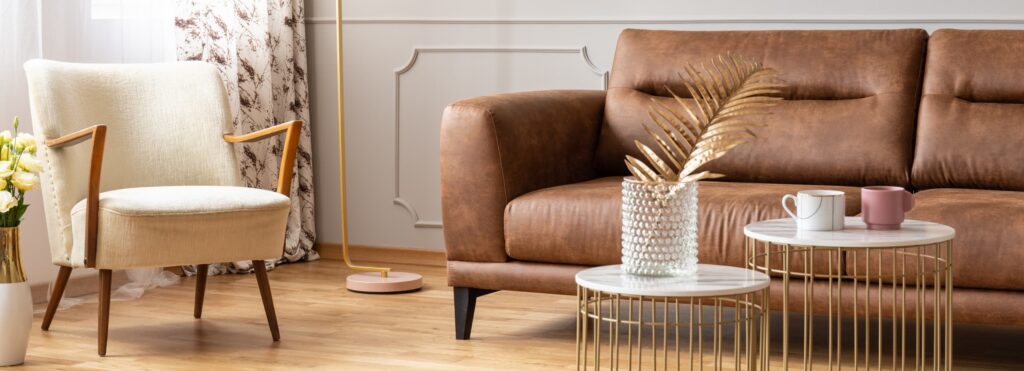Pros and Cons of Investing in a Leather Sofa

There are many factors to think about when choosing a new sofa, from the size you need and colour to how the style will work with your interior décor. But one of the most important decisions is whether to go with fabric or leather. Leather sofas are often seen as a premium option, offering a unique combination of elegance and durability, but like any investment, they also come with their own set of advantages and disadvantages. We’ll explore the pros and cons of investing in leather furniture, helping you make the right choice for your home.
The Benefits of Investing in a Leather Sofa
Durability and longevity
One of the main reasons people invest in leather sofas is their exceptional durability. Leather is a tough, resilient material that can withstand years of wear and tear, often outlasting fabric alternatives. A well-cared-for leather sofa can easily last 15 to 20 years, developing a beautiful patina if it’s maintained correctly, making it a long-term investment for your home.
Stain-resistant
Another benefit of leather is its natural resistance to stains. Thanks to the tanning process, leather develops a protective coating that prevents liquids and food spills from soaking in. This feature is especially valuable in homes with children or pets, where accidental spills are inevitable. Instead of worrying about deep stains like you would with textile furniture, a leather sofa allows for quick and easy clean-up.
Hypoallergenic properties
Leather’s hypoallergenic qualities make it a preferred choice for people who suffer with allergies. It doesn’t trap dust mites, pet dander, or other allergens that can accumulate in fabric sofas. So, if you’re sensitive to dust or other allergens, leather can create a cleaner, healthier environment in your home.
Timeless aesthetic and elegance
Leather has long been associated with luxury and sophistication. Whether it’s placed in a modern flat or a traditional living room, a leather sofa adds an unmistakable touch of elegance. Its sleek, timeless appearance suits a wide range of interior design styles, from contemporary to classic. Unlike fabric, which can wear and fade over time, leather develops a beautiful patina that enhances its character as it ages.
Sustainable option
For eco-conscious consumers, leather can be a more environmentally friendly choice than synthetic materials. Since it’s a natural product, leather biodegrades more easily than synthetic upholstery and it can be produced using sustainable processes. When well-maintained, a leather sofa also reduces waste by lasting longer, avoiding frequent replacements.
Downsides of Investing in a Leather Sofa
Higher initial cost
One of the most significant drawbacks of leather sofas is the price. Leather is generally more expensive than fabric due to its quality, durability and the craftsmanship involved in producing it. While the higher upfront cost can be offset by its long lifespan, this initial investment may be out of reach for some buyers.
Susceptibility to scratches
Although leather is durable, it’s not immune to damage. Sharp objects like pet claws or even zips on clothing can scratch the surface, which can be especially noticeable on certain types of leather. However, many leather sofas come with protective coatings, and there are products available to minimise or repair scratches, so this issue can be managed with care.
Limited colour and design options
When it comes to customisation, leather sofas offer fewer options compared to fabric. Fabric sofas are available in a vast array of colours, patterns and textures, allowing for more creativity when it comes to matching the sofa to your interior décor. Leather typically comes in solid, neutral tones, which may limit your design choices if you’re aiming for a specific look or want a bold colour scheme.
Temperature sensitivity
One of the common complaints about leather sofas is that they can feel uncomfortable depending on the room’s temperature. In the summer, leather can absorb heat and become sticky, while in the winter, it may feel cold to the touch. Unlike fabric, which tends to stay at a more consistent temperature, leather can require additional measures—like throws or cushions—to make it more comfortable in extreme weather. You’ll also need to be mindful of where you place leather furniture, as excessive sun exposure can dry out the leather.
Ultimately, whether a leather sofa is right for you depends on your lifestyle, budget, and design preferences. If you value durability, luxury, and easy cleaning, a leather sofa is an excellent choice. It’s important to consider your needs carefully before making this important investment in your home.
For professional cleaning services for your home, from furniture and upholstery to curtains and carpets, get in touch with Apple Clean today.
